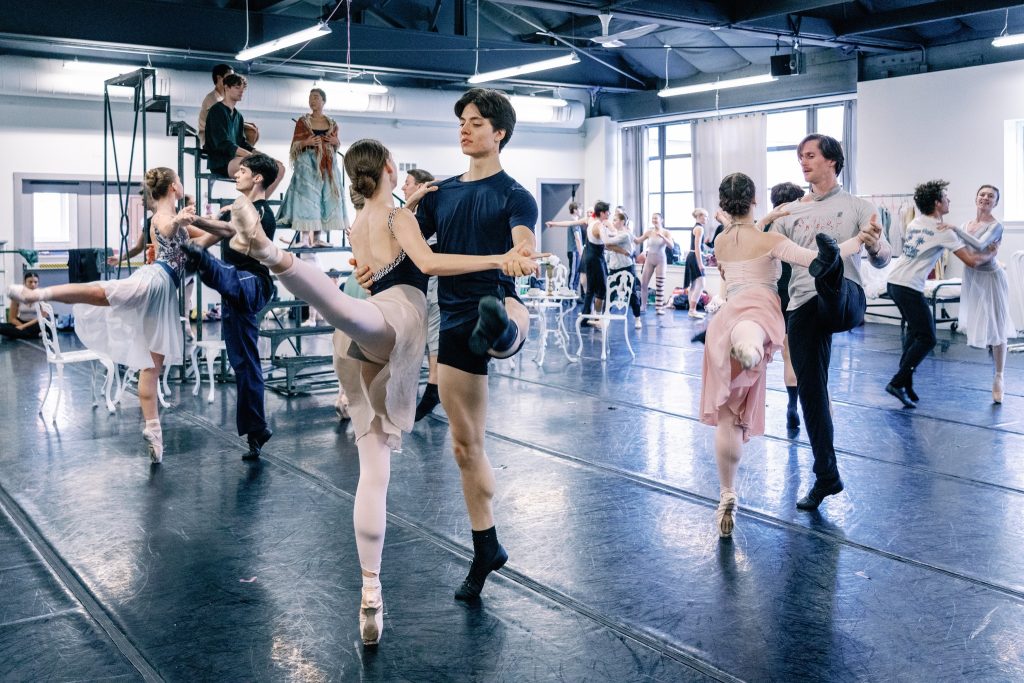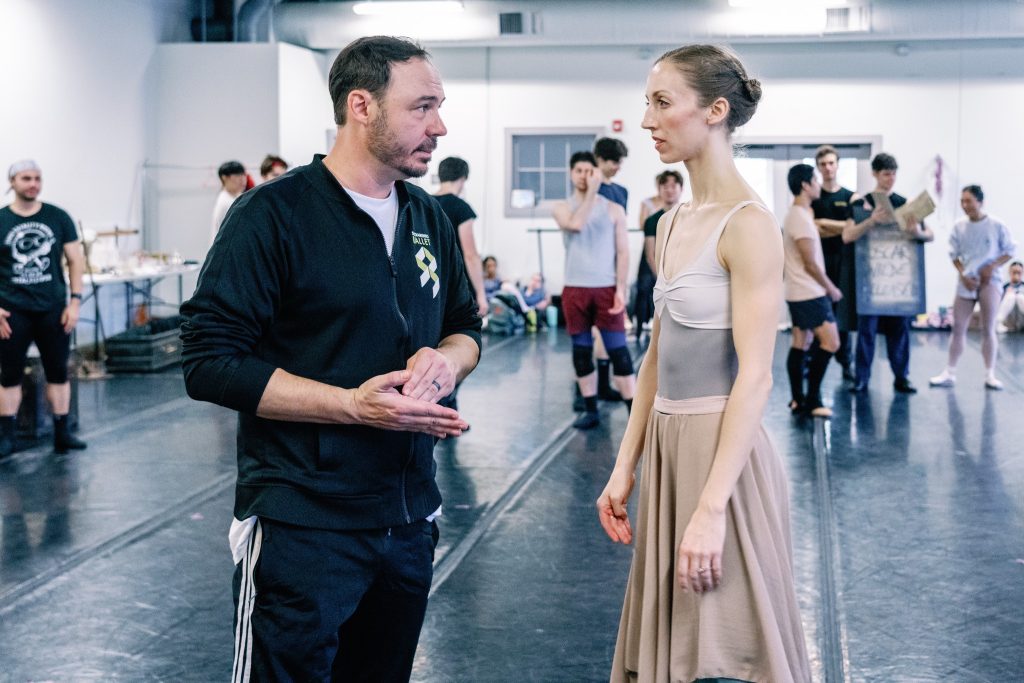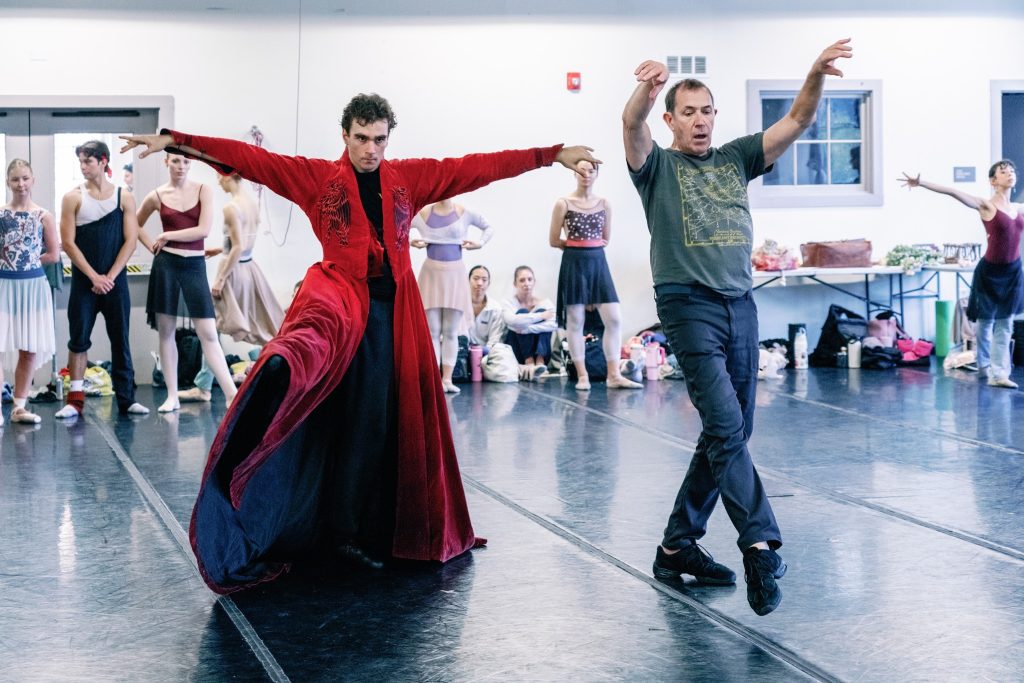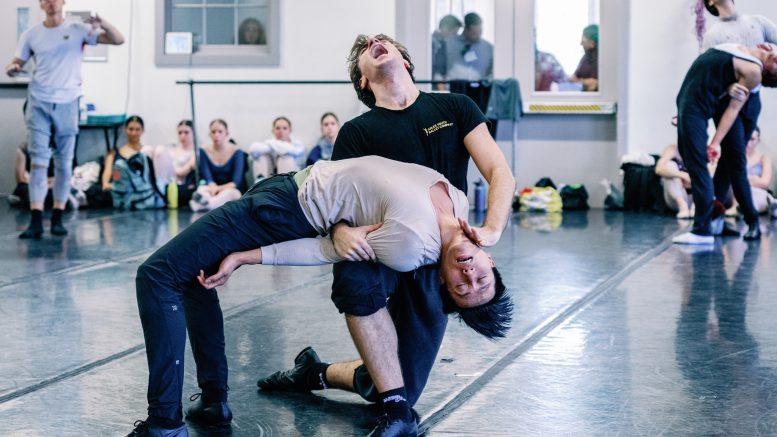By Marybeth Bizjak
Since 2021, Anthony Krutzkamp has been on a mission: to turn Sacramento Ballet into a world-class dance company that brings in-demand choreographers and innovative works to Sacramento audiences.
This year — the company’s 70th anniversary season — Krutzkamp’s campaign appears set to pay off, with a lineup featuring four world premieres as well as works by acclaimed choreographers Michael Pink and Young Soon Hue. People who think Sacramento Ballet is mainly a vehicle for armies of cute little kids to strut their stuff in “Nutcracker” are about to have their preconceptions challenged in a big way.
Krutzkamp joined Sacramento Ballet in 2017 as executive director to oversee the business end of things. At that time, Ron Cunningham and his wife, Carinne Binda, had run the artistic side for almost three decades, creating a company known largely for its focus on works by famed choreographer George Balanchine and by Cunningam himself.
A former principal dancer with Cincinnati Ballet, Krutzkamp has a business degree from Northeastern University and worked in management for Kansas City Ballet’s Second Company before coming to Sacramento. In 2018, the Cunninghams were ousted by the ballet’s board, with board president Nancy Garton telling The Sacramento Bee it was “time for us to look to Sac Ballet 2.0 so that we don’t one day wake up to say, ‘Oops! The parade passed us by.’” The couple’s replacement, Amy Seiwert, lasted only a couple of years before COVID struck, forcing the ballet to lay Seiwert off and cancel the remainder of its 2020-21 season.

In 2021, Krutzkamp was named artistic director while retaining his position as executive director, making him one of only a handful of executive/artistic ballet directors in the country. In his artistic role, the 43-year-old hires and trains dancers, and selects and mounts the works performed by the company, which has about two dozen full-time, salaried dancers. It is his “dream job,” he says. “I skip to work.”
Right from the start, Krutzkamp knew exactly where he wanted to move the ballet artistically. Balanchine and “Nutcracker” were fine — the classics had served Sacramento well for many years. But he envisioned opening Sacramento up to the greater ballet world by showcasing fresh, forward-thinking contemporary works, cutting-edge choreographers and increased theatrical values. In other words: newer, bigger, better.
He understood it would take several years to get the company where he wanted it to go — that it wouldn’t happen overnight. To work his way up to “Dracula” in 2024, he first had to do “Cinderella” a year earlier. And in order to attract star choreographers, he would have to prove that his dancers were equal to the job. “When you want to work with a choreographer, they ask to see the company,” he explains.
In 2022, he held auditions in France and hired Australian dancer Ugo Frediani and French dancer Maxence Devaux. The company, which also has dancers from the Philippines, Brazil and Japan, is one of the country’s fastest growing in terms of geographic diversity, according to Krutzkamp.
Every year on March 1, Krutzkamp publicly announces the lineup for the upcoming season. Because he wants the dancers to hear the news directly from him, he unveils the season to the company the day before the press release goes out. So on the last day of February 2024, the dancers gathered after lunch in Studio 1 — their airy classroom and rehearsal space on the second floor of CLARA. Formally known as the E. Claire Raley Studios for the Performing Arts, CLARA is a handsome decommissioned brick elementary school building on N Street that is home to Sacramento Ballet, Capital Stage, an Irish dancing school and other arts groups.

Krutzkamp told the dancers they would perform the world premiere of Hue’s “Romeo and Juliet” in February and a mixed repertory program called “Visions,” featuring world premieres by leading choreographers, in March. They would kick off the season Halloween weekend (Nov. 1-3) with Pink’s “Dracula” at SAFE Credit Union Performing Arts Center. “They were very, very excited,” Krutzkamp recalls.
Longtime Sac Ballet fans needn’t worry: The schedule also includes two old favorites: the classic holiday confection “Nutcracker” (Dec. 13–22) and “Beer & Ballet” (May 29–June 1), featuring choreography by the company’s dancers, served up with a glass of beer or wine.
The dancers already knew of Pink and his celebrated take on “Dracula,” one of the most frequently performed ballet versions of the classic tale of the bloodthirsty Transylvanian nobleman, based on the novel by Bram Stoker. Pink, a 68-year-old Englishman who in his youth danced with London Festival Ballet (now called English National Ballet), created “Dracula” in 1996 with music by composer Philip Feeney. The ballet, which has been performed all over the world, is known for its dramatic storytelling, sensual movements and athletically demanding partnering. (In one dreamy pas de deux, Dracula lifts and manipulates a sleeping Jonathan Harker like a rag doll.)
Krutzkamp worked with Pink in 2014 when he danced the role of Dracula in Kansas City and was keen to bring the ballet to Sacramento. About a year ago, he called the choreographer, who is also artistic director for Milwaukee Ballet, to pitch the idea. “It was a pleasant phone call,” says Pink, who employs a team of people to help companies like Sacramento Ballet stage his work.
His team first had to ensure that Sacramento could accommodate the elaborate production, which includes a massive bed weighing 500 pounds, built with a hidden trap door that allows Dracula to magically appear and disappear. Then, they negotiated royalties for the lighting, costumes, sets, music and choreographer. A major company like Boston Ballet with its $30 million annual budget pays top dollar, while Sacramento Ballet, with a budget that hovers around $4 million, pays less.

Pink typically spends the first and last week of the six-week rehearsal period with the company to help cast the leading roles, teach the choreography to the dancers and fine-tune the production before opening night. On Sept. 15, he flew into Sacramento at 10 p.m. and arrived at CLARA early the next morning to meet with Krutzkamp and the dancers, who had just returned from their long summer break.
By early afternoon, Pink had started pairing up partners and teaching them sections of the ballet. Tall and commanding, he demonstrated many of the steps himself. Sometimes he would gather the dancers around his laptop to study video of Milwaukee Ballet dancers performing the moves. For a scene from the third act set in Dracula’s tomb, he led the company through an eerie sequence in which the “undead” writhed and crawled on the floor, licking imaginary blood from their hands.
Pink says he knew nothing about the Sacramento company before coming to town and was pleasantly surprised by its caliber, adding, “There are very strong dancers here.” After five days in Sacramento, Pink returned to Milwaukee, sending his rehearsal director to work with the cast for the next five weeks.
Pink wasn’t in Sacramento for the final week of rehearsals because he had to prepare the Milwaukee Ballet for its opening of “Casanova” the same week. He regretted having to miss Sacramento’s opening night of “Dracula.” “I like to be present to hear the audience response,” says Pink, noting that audience members, even non-ballet fans, frequently react to Dracula like he’s a rock star. He has yet to meet a dancer who doesn’t consider it the best male role in dance. “Forget Romeo, forget the prince in ‘Swan Lake,’ Pink says. “It’s such an iconic character, with so many great moments.”

Krutzkamp has attended seven opening nights of “Dracula,” and each time the audience demanded a curtain call. “You expect that for ‘Swan Lake,’” Krutzkamp says, “not ‘Dracula.’”
With the 2024–25 season barely underway, Krutzkamp has already selected all the works for the 2025–26 season, as well as one piece for the season after that. (No, he won’t name them.) He’s proud of what he’s accomplished since taking the reins as artistic director. Bringing contemporary Korean choreographer Young Soon Hue to Sacramento was a coup. She has danced for Ballett am Rhein in Germany, one of Europe’s leading companies, and has created dozens of pieces and won multiple awards; until now, only one other U.S. company has performed her work.
She’ll spend six weeks here working with the Sacramento company on “Romeo and Juliet.” Krutzkamp believes she will elevate his dancers with her strong yet compassionate teaching style. “She expects a lot, but she does it in a caring way,” he says. “I call it ‘a kind demanding.’”
“Visions” also promises to level up the company’s game. It features new works by Amy Hall Garner, who has created pieces for New York City Ballet and Alvin Ailey American Dance Theater; Alfonso Palencia, chief choreographer of Germany’s State Theater Ballet Bremerhaven; and Thang Dao, who has choreographed for numerous companies. Sacramento Ballet dancer Julia Feldman will also debut a work she created.
During Krutzkamp’s dancing days, his work as an international guest artist gave him a wide network of friends in the ballet world, easing his path in bringing groundbreaking choreographers to Sacramento. “I already have their phone numbers,” he explains.
According to Sacramento Ballet’s current board president, Alyssa Paoletti, the company has benefited from those connections, and from Krutzkamp’s talent in attracting great dancers and choreographers and innovative works. “I truly believe our productions and dancers rival any major metropolitan areas’,” she says. “We have become an artistic hub because of Anthony, so you don’t need to venture beyond our city for artistic excellence.”
The changes Krutzkamp has implemented go beyond just providing Sacramentans a few thrilling performances each year. A vibrant ballet company that looks past city borders raises Sacramento’s profile outside the region, bringing in tourism, development and investment. It attracts people to downtown restaurants and cultural offerings. Perhaps most importantly, it improves the quality of life for the people who live here. “The creative process is happening here,” Krutzkamp says. “It’s a big deal. I’m very proud of that.”
This story was funded by the City of Sacramento’s Arts and Creative Economy Journalism Grant to Solving Sacramento. Following our journalism code of ethics and protocols, the city had no editorial influence over this story and no city official reviewed this story before it was published. Our partners include California Groundbreakers, Capital Public Radio, Outword, Russian America Media, Sacramento Business Journal, Sacramento News & Review, Sacramento Observer and Univision 19. Sign up for our “Sac Art Pulse” newsletter here.


Be the first to comment on "At 70, Sacramento Ballet plots a new course — looking beyond ‘Nutcracker’ to contemporary works and boundary-breaking choreographers "